Comparison of Closed Chamber and Eddy Covariance Methods to Improve the Understanding of Methane Fluxes from Rice Paddy Fields in Japan
Abstract
:1. Introduction
2. Material and Methods
2.1. Field Design
2.2. Measurement of CH4 Concentrations Using Soil Gas Sampling Tubes
2.3. Measurement of CH4 Fluxes Using the Closed Chamber Method
2.4. Measurement of CH4 Fluxes Using the Eddy Covariance Method
2.5. Measurement of Soil and Environmental Parameters
2.6. Statistical Analysis of Data
3. Results
3.1. Environmental Conditions at Experimental Site
3.2. Methane Concentration in Soil
3.3. Methane Fluxes from Soil Surface
3.4. Influence of Environmental Factors on CH4 Flux
3.5. The EC Footprint Analysis and CH4 Fluxes Using CC Method
4. Discussion
4.1. Diurnal and Seasonal Variation in CH4 Emission
4.2. Influence of Sampling Position on CH4 Flux
4.3. Comparison between the CC and EC Methods Used in This Study
5. Conclusions
Author Contributions
Funding
Acknowledgments
Conflicts of Interest
References
- Wassmann, R.; Papen, H.; Rennenberg, H. Methane Emission from rice paddies and possible mitigation strategies. Chemosphere 1993, 26, 201–217. [Google Scholar] [CrossRef]
- Wassmann, R.; Neue, H.U.; Lantin, R.S.; Makarim, K.; Chareonsilp, N.; Buendia, L.V.; Rennenberg, H. Characterization of methane emissions from rice fields in Asia II. Differences among irrigated, rainfed, and deepwater rice. Nutr. Cycl. Agroecosyst. 2000, 58, 13–22. [Google Scholar] [CrossRef]
- Zschornack, T.; Bayer, C.; Zanatta, J.; Vieira, F.; Anghinoni, I. Mitigation of methane and nitrous oxide emissions from flood-irrigated rice by no incorporation of winter crop residues into the soil. Rev. Bras. Cienc. Solo 2011, 35, 623–634. [Google Scholar] [CrossRef] [Green Version]
- Whalen, S.C. Biogeochemistry of methane exchange between natural wetlands and the atmosphere. Environ. Eng. Sci. 2005, 22, 73–94. [Google Scholar] [CrossRef]
- Hendriks, D.M.D.; van Huissteden, J.; Dolman, A.J. Multi-technique assessment of spatial and temporal variabitity of methane fluxes in a peat meadow. Agric. For. Meteorol. 2010, 150, 757–774. [Google Scholar] [CrossRef]
- Oo, A.Z.; Nguyen, L.; Win, K.T.; Cadisch, G.; Bellingrath-Kimura, S.D. Toposequential variation in methane emissions from double-cropping paddy rice in Northwest Vietnam. Geoderma 2013, 209–210, 41–49. [Google Scholar] [CrossRef]
- Castro, M.S.; Steudler, P.A.; Melillo, J.M.; Aber, J.D.; Bowden, R.D. Factor controlling atmospheric methane consumption by temperate forest soils. Glob. Biogeochem. Cycles 1995, 9, 1–10. [Google Scholar] [CrossRef]
- Komiya, S.; Noborio, K.; Shoji, Y.; Yazaki, T.; Theerayut, T. Measuring CH4 flux in a rice paddy field in Thailand using relaxed eddy accumulation (REA) method. J. Jpn. Soc. Soil Phys. 2014, 128, 23–31. (In Japanese) [Google Scholar]
- Yu, L.; Wang, H.; Wang, G.; Song, W.; Huang, Y.; Li, S.-G.; Liang, N.; Tang, Y.; He, J.-S. A comparison of methane emission measurements using eddy covariance and manual and automated chamber-based techniques in Tibetan Plateau alpine wetland. Environ. Pollut. 2013, 181, 81–90. [Google Scholar] [CrossRef] [PubMed]
- Jia, Z.; Cai, Z.; Xu, H.; Li, X. Effect of rice plants on CH4 production, transport, oxidation and emission in rice paddy soil. Plant Soil 2001, 230, 211–221. [Google Scholar] [CrossRef]
- Kimura, M.; Miura, Y.; Watanabe, A.; Katoh, T.; Haraguchi, H. Methane Emission from Paddy Field (Part 1) Effect of Fertilization, Growth Stage and Midsummer Drainage: Pot Experiment. Environ. Sci. 1991, 4, 265–271. [Google Scholar] [CrossRef]
- Katayanagi, N.; Hatano, R. Spatial variability of greenhouse gas fluxes from soils of various land uses on a livestack farm in Southern Hokkaida, Japan. Phyton 2005, 45, 309–318. [Google Scholar]
- Pakoktom, T.; Chaichana, N.; Phattaralerphong, J.; Sathornkich, J. Carbon Use Efficiency of the First Ratoon Cane by Eddy Covariance Technique. Int. J. Environ. Sci. Dev. 2013, 4, 488–491. [Google Scholar] [CrossRef]
- Komiya, S.; Noborio, K.; Katano, K.; Kondo, F. Methane and carbon dioxide dynamics over a rice-cropping season in Japan. In Proceedings of the AsiaFlux Workshop 2014 “Bridging Atmospheric Flux Monitoring to National and International Climate Change Initiatives”, Los Banos, Philippines, 18–23 August 2014; AsiaFlux: Los Banos, Philippines, 2014. [Google Scholar]
- Baldocchi, D. Assessing the eddy covariance technique technique for evaluating carbon dioxide exchange rates of ecosystems: Past, present and future. Glob. Chang. Biol. 2003, 9, 479–492. [Google Scholar] [CrossRef]
- Liu, H.Z.; Feng, J.W.; Järvi, L.; Vesala, T. Four-year (2006–2009) eddy covariance measurements of CO2 flux over an urban area in Beijing. Atmos. Chem. Phys. 2012, 12, 7881–7892. [Google Scholar] [CrossRef]
- Wang, K.; Zheng, X.; Pihlatie, M.; Vesala, T.; Liu, C.; Haapanala, S.; Mammarella, I.; Rannik, Ü.; Liu, H. Comparison between static chamber and tunable diode laser-based eddy covariance techniques for measuring nitrous oxide fluxes from a cotton field. Agric. For. Meteorol. 2013, 171–172, 9–19. [Google Scholar] [CrossRef]
- Meijide, A.; Manca, G.; Goded, I.; Magliulo, V.; di Tommasi, P.; Seufert, G.; Cescatti, A. Seasonal trends and environmental controls of methane emissions in a rice paddy field in Northern Italy. Biogeosciences 2011, 8, 3809–3821. [Google Scholar] [CrossRef] [Green Version]
- Riederer, M.; Serafimovich, A.; Foken, T. Net ecosystem CO2 exchange measurements by the closed chamber method and the eddy covariance technique and their dependence on atmospheric conditions. Atmos. Meas. Tech. 2014, 7, 1057–1064. [Google Scholar] [CrossRef] [Green Version]
- Mauder, M.; Foken, T. Documentation and Instruction Manual of the Eddy-Covariance Software Package TK3 (Update). Available online: https://epub.uni-bayreuth.de/id/eprint/2130 (accessed on 10 February 2015).
- Schmid, H.P. Footprint modeling for vegetation atmosphere exchange studies; a review and perspective. Agric. For. Meteorol. 2002, 113, 159–183. [Google Scholar] [CrossRef]
- Aubinet, M.; Vesala, T.; Papale, D. Eddy Covariance: A Practical Guide to Measurement and Data Analysis; Springer: Dordrecht, UK, 2012; p. 438. [Google Scholar]
- Burba, G. Illustration of flux footprint estimates affected by measurement height, surface roughness and thermal stability. In Automated Weather Stations for Applications in Agriculture and Water Resources Management; Hubbards, K., Sivakumar, M., Eds.; World Meteorological Organization: Geneva, Switzerland, 2001; pp. 77–86. [Google Scholar]
- Food and Agriculture Organization of the United Nations. FAO-Unesco Soil Map of the World: Legend; UNESCO: Paris, France, 1971. [Google Scholar]
- Buendia, L.V.; Neue, H.U.; Wassmann, R.; Lantin, R.S.; Javellana, A.M.; Arah, J.; Wang, Z.; Wangfang, L.; Makarim, A.K.; Corton, T.M.; et al. An efficient sampling strategy for estimating methane emission from rice field. Chemosphere 1998, 36, 395–407. [Google Scholar] [CrossRef]
- Minami, K.; Yagi, K.; Tokida, T.; Sander, B.O.; Wassmann, R. Appropriate frequency and time of day to measure methane emissions from an irrigated rice paddy in Japan using the manual closed chamber method. Greenh. Gas Meas. Manag. 2012, 2, 118–128. [Google Scholar] [CrossRef]
- Kusa, K.; Sawamoto, T.; Hu, R.; Hatano, R. Comparison of N2O and CO2 concentrations and fluxes in the soil profile between a Gray Lowland soil and an Andosol. J. Soil Sci. Plant Nutr. 2010, 56, 186–199. [Google Scholar] [CrossRef]
- Theint, E.E.; Suzuki, S.; Ono, E.; Bellingrath-Kimura, S.D. Influence of different rates of gypsum application on methane emission from saline soil related with rice growth and rhizosphere exudation. Catena 2015, 133, 467–473. [Google Scholar] [CrossRef]
- Mu, Z.; Kimura, S.D.; Hatano, R. Estimation of global warming potential from upland cropping systems in central Hokkaido, Japan. J. Soil Sci. Plant Nutr. 2006, 52, 371–377. [Google Scholar] [CrossRef] [Green Version]
- Qun, D.; Huizhi, L. Seven years of carbon dioxide exchange over a degraded grassland and cropland wiht ecosystems in a semiarid area of China. Agric. Ecosyst. Environ. 2013, 173, 1–12. [Google Scholar] [CrossRef]
- Kormann, R.; Meixner, F.X. An analytical footprint model for non-neutral stratification. Bound.-Layer Meteorol. 2000, 99, 207–224. [Google Scholar] [CrossRef]
- Becker, T.; Kutzbach, L.; Forbrich, I.; Schneider, J.; Jager, D.; Thees, B.; Wilmking, M. Do we miss the hot spots?—The use of very high resolution aerial photographs to quantify carbon fluxes in peatlands. Biogeosciences 2008, 5, 1387–1393. [Google Scholar] [CrossRef]
- Budishchev, A.; Mi, Y.; van Huissteden, J.; Belelli-Marchesini, L.; Schaepman-Strub, G.; Parmentier, F.J.W.; Fratini, G.; Gallagher, A.; Maximov, T.C.; Dolman, A.J. Evaluation of a plot-scale methane emission model using eddy covariance observation and footprint modelling. Biogeosciences 2014, 11, 4651–4664. [Google Scholar] [CrossRef] [Green Version]
- Baldocchi, D. Flux footprints within and over forest canopies. Bound.-Layer Meteorol. 1997, 85, 273–292. [Google Scholar] [CrossRef]
- Neue, H.U.; Wassmann, R.; Kludze, H.K.; Bujun, W.; Lantin, R.S. Factors and processes controlling methane emissions from rice fields. Nutr. Cycl. Agroecosyst. 1997, 49, 111–117. [Google Scholar] [CrossRef]
- Chanton, J.P.; Whiting, G.J.; Blair, N.E.; Lindau, C.W.; Bollich, P.K. Methane emission from rice: Stable isotopes, diurnal variations, and CO2 exchange. Glob. Biogeochem. Cycles 1997, 11, 15–27. [Google Scholar] [CrossRef]
- Dacey, J.W.H. Internal winds in water lilies: An adaptation for life in anaerobic sediments. Science 1980, 210, 1017–1019. [Google Scholar] [CrossRef] [PubMed]
- Nouchi, I.; Hosono, T.; Aoki, K.; Minami, K. Seasonal variation in methane flux from rice paddies associated with methane concentration in soil water, rice biomass and temperature, and its modelling. Plant Soil 1994, 161, 195–208. [Google Scholar] [CrossRef]
- Bosse, U.; Frenzel, P. Activity and distribution of methane-oxidizing bacteria in flooded rice soil microcosms and in rice plants (Osyza sativa). Appl. Environ. Microbiol. 1997, 63, 1199–1207. [Google Scholar] [PubMed]
- Yang, S.-S.; Chang, H.-L. Diurnal variation of methane emission from paddy fields at different growth stages of rice cultivation in Taiwan. Agric. Ecosyst. Environ. 1999, 76, 75–84. [Google Scholar] [CrossRef]
- Alberto, M.C.R.; Wassmann, R.; Buresh, R.J.; Quilty, J.R.; Correa, T.Q., Jr.; Sandro, J.M.; Centeno, C.A.R. Measuring methane flux from irrigated rice fields by eddy covariance method using open-path gas analyzer. Field Crops Res. 2014, 160, 12–21. [Google Scholar] [CrossRef]
- Wang, Z.-P.; Han, X.-G. Diurnal variation in methane emissions in relation to plants and environmental variables in the Inner Mongolia marshes. Atmos. Environ. 2005, 39, 6295–6305. [Google Scholar] [CrossRef]
- Zhang, Y.; Sachs, T.; Li, C.; Boike, J. Upscaling methane fluxes from closed chambers to eddy covariance based on a permaforest biogeochemistry integrated model. Glob. Chang. Biol. 2012, 18, 1428–1440. [Google Scholar] [CrossRef]
- Tariq, A.; Vu, Q.D.; Jensen, L.S.; de Tourdonnet, S.; Sander, B.O.; Wassmann, R.; Mai, T.V.; de Neergaard, A. Mitigating CH4 and N2O emissions from intensive rice production systems in northern Vietnam: Efficiency of drainage pattern in combination with rice residue incorpation. Agric. Ecosyst. Environ. 2017, 249, 101–111. [Google Scholar] [CrossRef]
- Clements, R.J.; Verma, S.B.; Verry, E.S. Relating chamber measurements to eddy correlation measurements of methane flux. J. Geophys. Res. 1995, 100, 21047–21056. [Google Scholar] [CrossRef]
- Schrier-Uijl, A.P.; Kroon, P.S.; Hensen, A.; Leffelaar, P.A.; Berendse, F.; Veenendaal, E.M. Comparison of chamber and eddy covariance-based CO2 and CH4 emission estimates in a heterogeneous grass ecosystem on peat. Agric. For. Meteorol. 2010, 150, 825–831. [Google Scholar] [CrossRef]
- Brændholt, A.; Larsen, K.S.; Ibrom, A.; Pilegaard, K. Overestimation of closed-chamber soil CO2 effluxes at low atmospheric turbulence. Biogeosciences 2017, 14, 1603–1616. [Google Scholar] [CrossRef]
- Foken, T.; Aubinet, M.; Leuning, R. The eddy-covariance method. In Eddy Covariance: A Pratical Guide to Measurements and Data Analysis; Aubinet, M., Vesala, T., Papale, D., Eds.; Springer: Heidelberg, Germany, 2012; pp. 1–9. [Google Scholar]
- Thomas, C.; Foken, T. Flux contribution of coherent structures and its implications for the exchange of energy and matter in a tall spruce canopy. Bound.-Layer Meteorol. 2007, 123, 317–337. [Google Scholar] [CrossRef]
- Bolstad, P.V.; Davis, K.J.; Martin, J.; Cook, B.D.; Wang, W. Component and whole-system respiration fluxes in northern deciduous forest. Tree Physiol. 2004, 24. [Google Scholar] [CrossRef]
- Christensen, S.; Ambus, P.; Arah, J.R.M.; Claton, H.; Galle, B.; Griffith, W.T.; Hargreaves, K.J.; Klemedtsson, L.; Lind, A.M.; Maag, M.; et al. Notrous oxide emission from an agricultural field: Comparison between measurements by flux chamber and micrometerological techniques. Atmos. Environ. 1996, 30, 4183–4190. [Google Scholar] [CrossRef]
- Erkkila, K.M.; Mammarella, I.; Bastviken, D.; Biermann, T.; Heiskanen, J.; Lindroth, A.; Peltola, O.; Rantakari, M.; Vesala, T.; Ojala, A. Methane and carbon dioxide fluxes over a lake: Comparison between eddy covariance, floating chambers and boundary layer method. Biogeosci. Discuss. 2017. [Google Scholar] [CrossRef]
- Sander, B.O.; Wassmann, R. Common practices for manual greenhouse gas sampling in rice production: A literature study on sampling modalities of the closed chamber method. Greenh. Gas Meas. Manag. 2014, 4, 1–13. [Google Scholar] [CrossRef]
- Werle, P.; Kormann, R. Fast chemical sensor for eddy-correlation measurements of methane emissions from rice paddy fields. Appl. Opt. 2001, 40, 846–858. [Google Scholar] [CrossRef] [PubMed]
- Baldocchi, D.; Detto, M.; Sonnentag, O.; Verfaillie, J.; Teh, Y.A.; Silver, W.; Kelly, N.M. The challenges of measuring methane fluxes and concentrations over a peatland pasture. Agric. For. Meteorol. 2011, 153, 177–187. [Google Scholar] [CrossRef]
- Reth, S.; Göckede, M.; Falge, E. CO2 efflux from agricultural soils in Eastern Germany—Comparison of closed chamber system with eddy covariance measurements. Theor. Appl. Climatol. 2005, 80, 105–120. [Google Scholar] [CrossRef]
- Lewicki, J.L.; Fischer, M.L.; Hilley, G.E. Six-week time series of eddy covariance CO2 flux at Mammoth Mountain, California: Performance evaluation and role of meteorological forcing. J. Volcanol. Geotherm. Res. 2008, 171, 178–190. [Google Scholar] [CrossRef]
- Sachs, T.; Giebels, M.; Boike, J.; Kutzbach, L. Environmental controls on CH4 emission from polygonal tundra on the microsite scale in the Lena river delta, Siberia. Glob. Chang. Biol. 2010, 16, 3096–3110. [Google Scholar] [CrossRef]

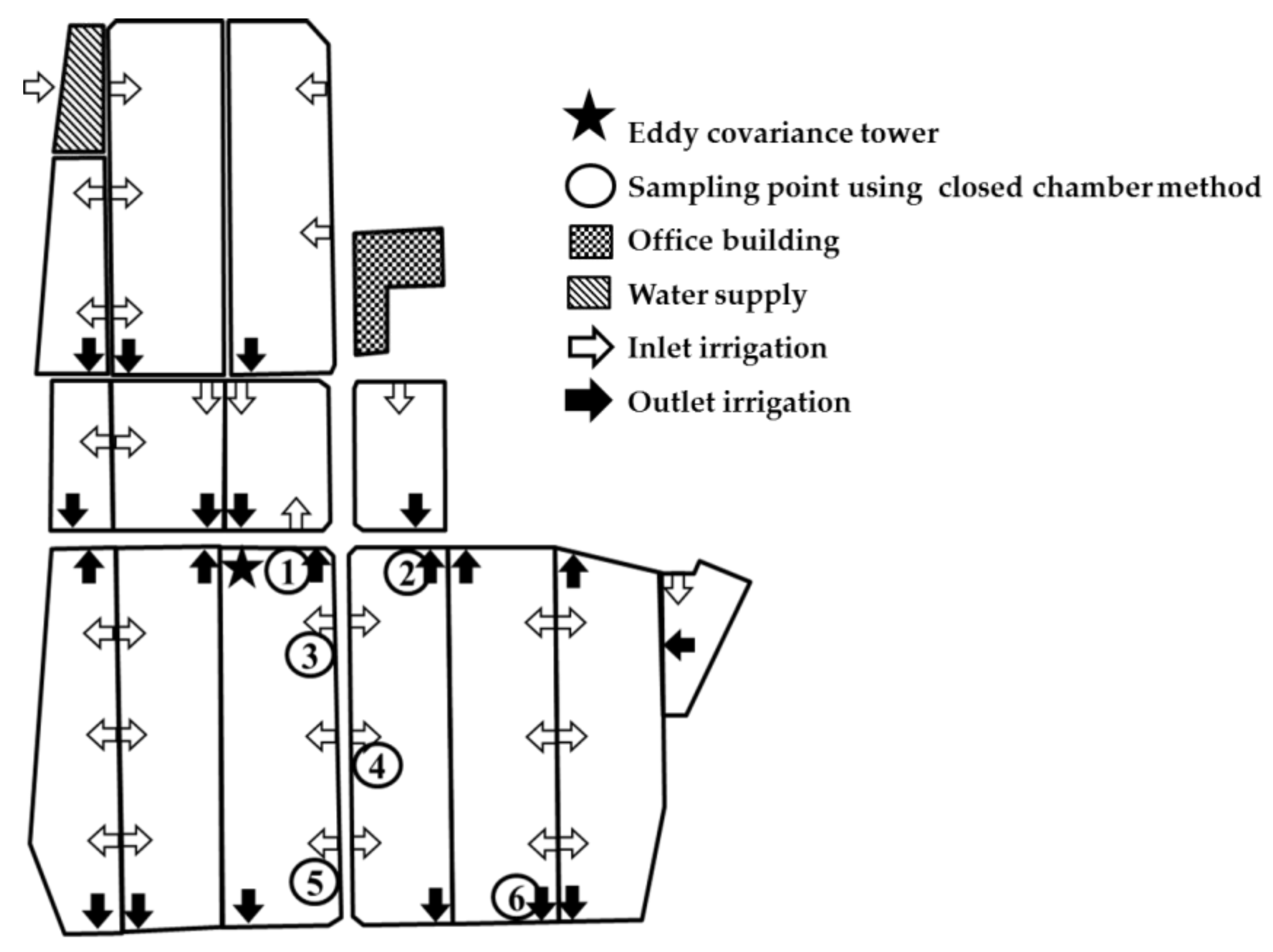
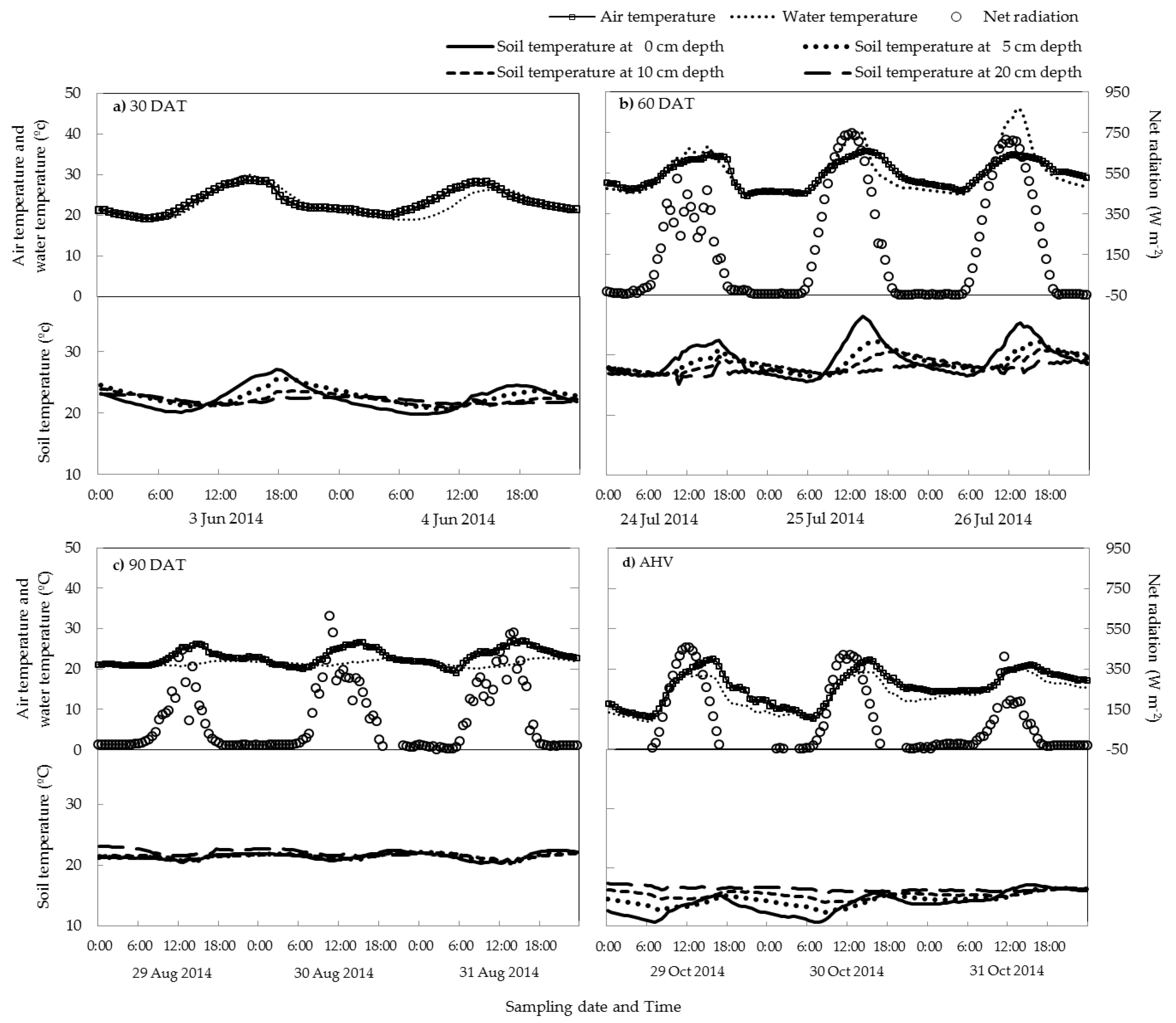
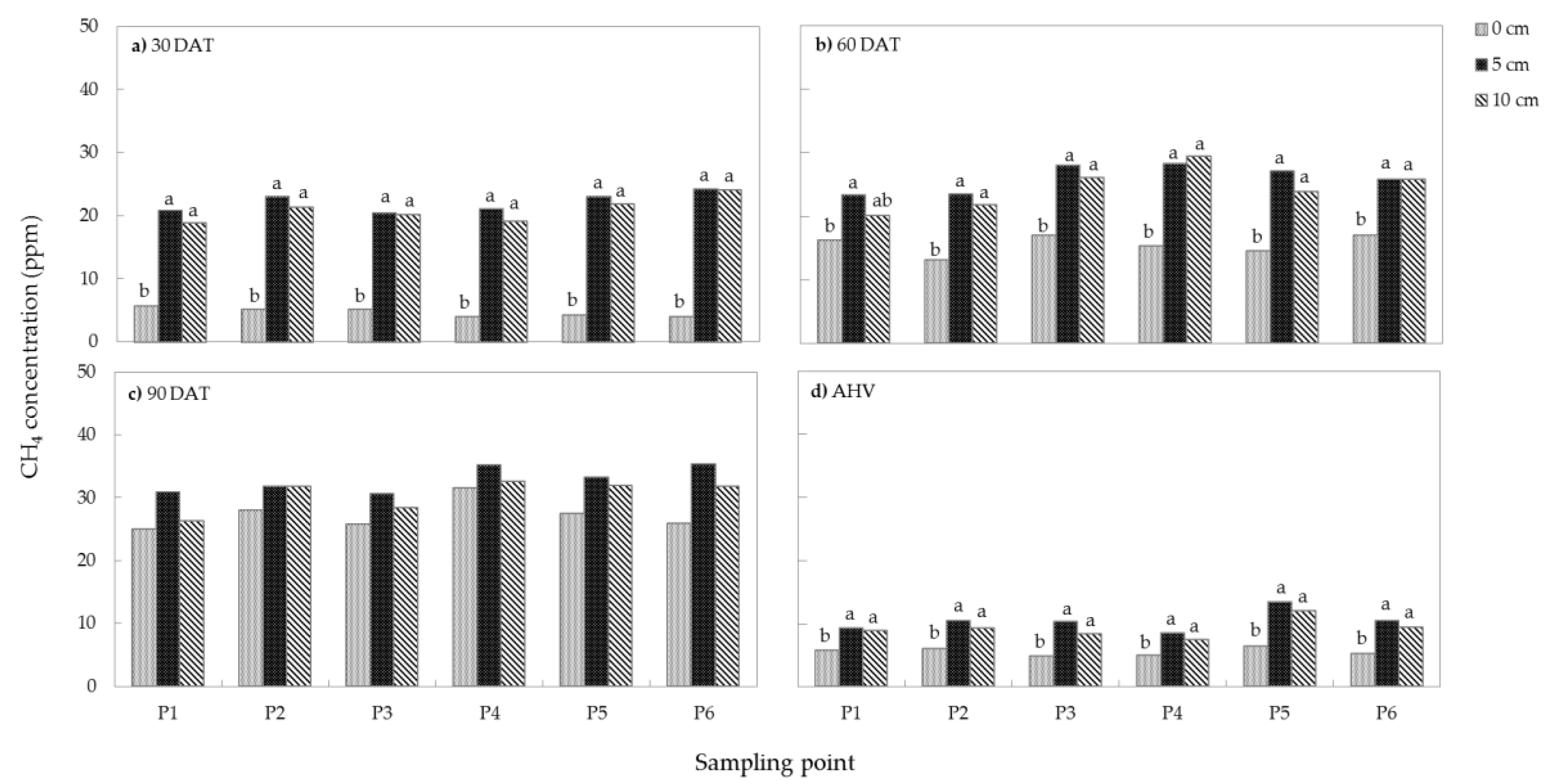
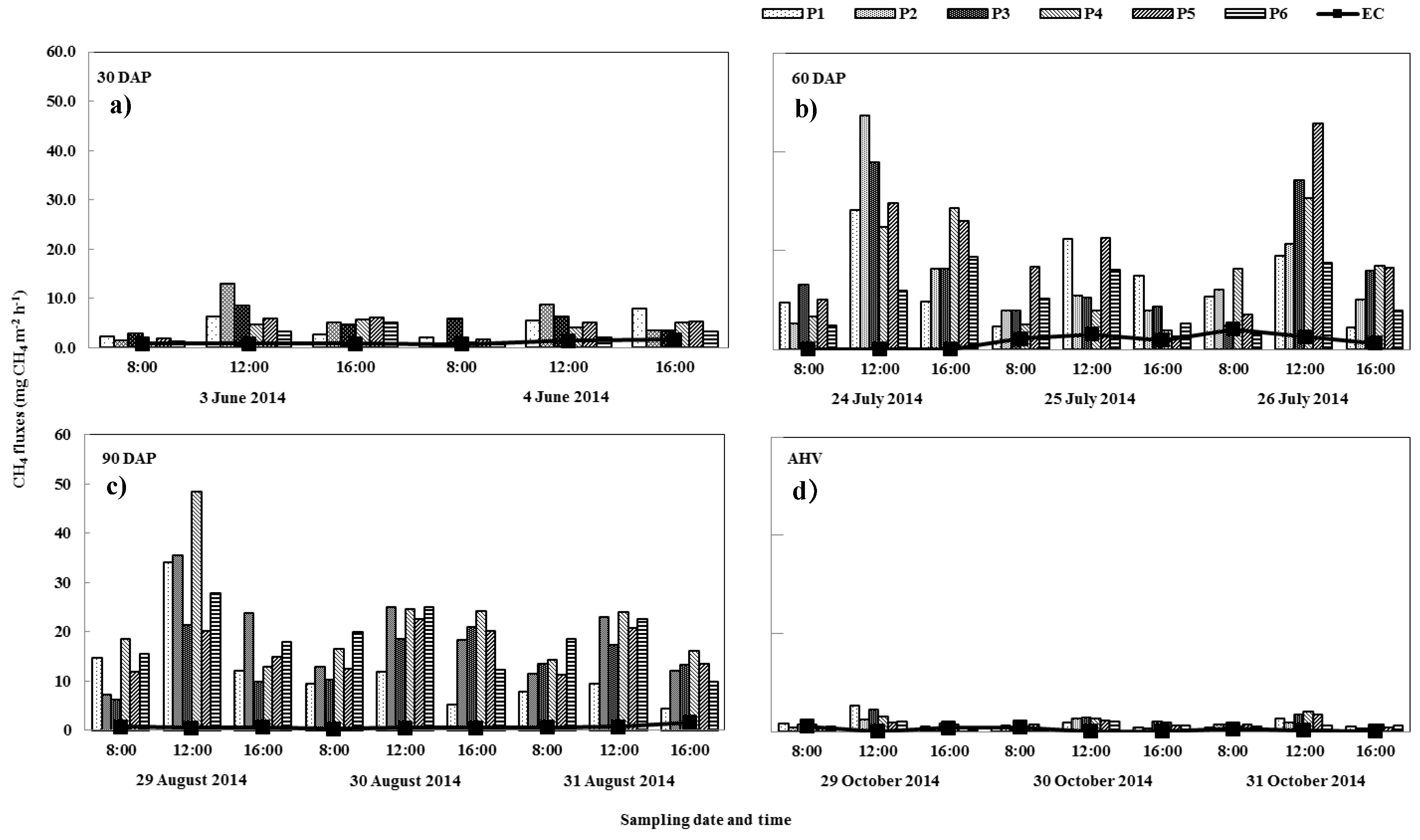
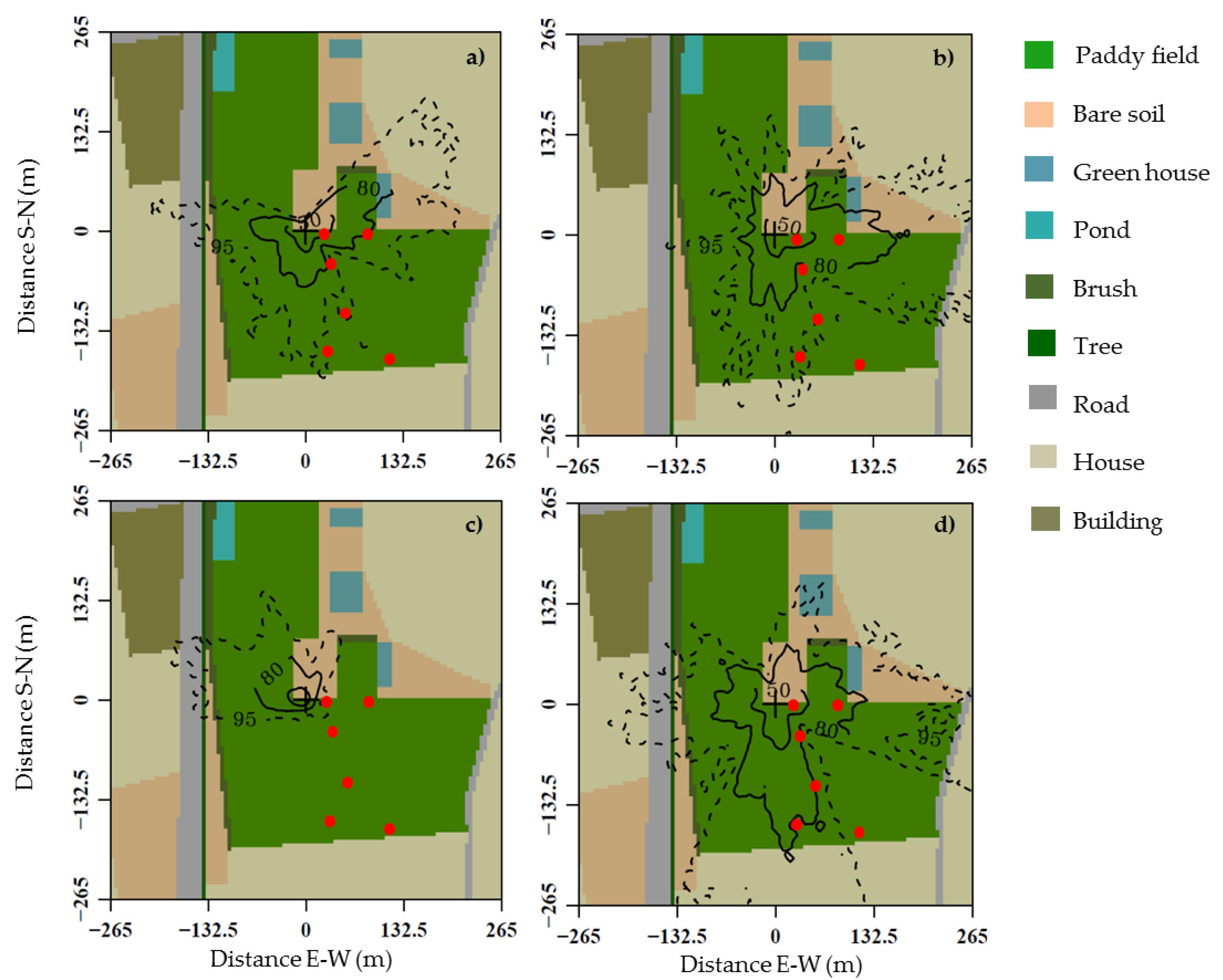
| Sampling Point | Soil pH | Electrical Conductivity (mS m−1) | TC (g kg−1) | TN (g kg−1) | C/N | SOM (%) | NH4+ (mgN kg−1) | NO3− (mgN kg−1) |
|---|---|---|---|---|---|---|---|---|
| 1 | 6.2 | 9.8 ab | 41.3b | 3.7 | 11.0 | 11.1 | 0.1 | 13.5 |
| 2 | 6.4 | 6.2 c | 40.6b | 4.2 | 10.3 | 10.2 | 0.1 | 15.0 |
| 3 | 6.4 | 11.6a | 46.7a | 4.0 | 11.6 | 10.0 | 0.1 | 14.0 |
| 4 | 6.5 | 8.7 b | 43.3ab | 3.9 | 11.3 | 9.8 | 0.1 | 14.2 |
| 5 | 6.6 | 8.0 bc | 43.2ab | 3.8 | 12.0 | 9.8 | 0.1 | 9.2 |
| 6 | 6.4 | 7.7 bc | 39.8b | 3.6 | 11.2 | 9.7 | 0.1 | 8.7 |
| p-value | 0.08 | 0.002 ** | 0.05 * | 0.55 | 0.16 | 0.79 | 0.72 | 0.14 |
| Predictors | Stepwise Regression (R = 0.67, R2 = 0.44, F = 7.370, p < 0.001) | |||
|---|---|---|---|---|
| B | SE | β | p | |
| Constant | −2929.460 | 1178.943 | 0.140 | |
| pH | 365.116 | 130.760 | 0.465 | 0.006 |
| Electrical conductivity (EC) | 3.137 | 4.444 | 0.056 | 0.481 |
| Total Carbon (TC) | 4.812 | 7.448 | 0.175 | 0.519 |
| Total Nitrogen (TN) | −96.206 | 116.422 | −0.304 | 0.410 |
| C/N ratio | −41.108 | 21.673 | −0.303 | 0.059 |
| Soil Organic Matter (SOM) | 18.850 | 14.640 | 0.207 | 0.199 |
| Ammonium ion concentration (NH4+) | 516.027 | 581.454 | 0.356 | 0.376 |
| Nitrate ion concentration (NO3−) | 1.080 | 13.555 | 0.016 | 0.937 |
| Plant height | 0.258 | 1.150 | 0.046 | 0.823 |
| Tiller number | 3.665 | 1.987 | 0.161 | 0.067 |
| Net radiation | 0.175 | 0.072 | 0.308 | 0.016 |
| Air Temperature inside CC | −0.297 | 1.468 | −0.018 | 0.840 |
| Soil Temperature inside CC | 7.343 | 3.471 | 0.265 | 0.036 |
| Air temperature in ecosystem | 66.760 | 18.305 | 2.960 | 0.000 |
| Soil temperature at 0 cm depth | −77.983 | 20.269 | −3.995 | 0.000 |
| Soil temperature at 5 cm depth a | - | - | - | - |
| Soil temperature at 10 cm depth | 72.155 | 46.748 | 2.536 | 0.124 |
| Soil temperature at 20 cm depth | −87.776 | 46.533 | −2.502 | 0.061 |
| Water temperature in ecosystem | 13.103 | 6.670 | 0.879 | 0.051 |
| Ground heat flux | 4.167 | 1.939 | 0.754 | 0.033 |
| Relative humidity | 12.133 | 3.647 | 1.252 | 0.001 |
| Wind speed | 27.642 | 26.787 | 0.149 | 0.303 |
| Growing Stage | Sampling Day | EC Footprint Area Cover (m−2) | Area Cover (%) | Average CH4 Fluxes (mg CH4 m−2 h−1) | Upscaling CH4 Emission (g CH4 h−1) | |||||
|---|---|---|---|---|---|---|---|---|---|---|
| Campaing Period | 9:00–14:00 | |||||||||
| Rice Field | Bare Soil | Other | Fcc | Fec | Fcc | Fec | ||||
| 30 DAT | 3 June 2014 | 1995 | 86 | 13 | 1 | 4.3 | 1.3 | 6.9 | 1.3 | 7.4 |
| 4 June 2014 | 2903 | 88 | 11 | 0 | 3.8 | 2.0 | 5.8 | 2.3 | 9.8 | |
| 2 days continuous a | 3470 | 84 | 14 | 2 | 4.1 | 1.7 | 6.4 | 1.8 | 11.9 | |
| 60 DAT | 24 July 2014 | 5041 | 79 | 16 | 4 | 17.8 | 2.6 | 30.6 | 1.6 | 71.1 |
| 25 July 2014 | 3513 | 82 | 16 | 2 | 10.4 | 3.8 | 15.1 | 3.6 | 30.1 | |
| 26 July 2014 | 2017 | 77 | 14 | 8 | 14.2 | 4.3 | 25.7 | 4.7 | 22.1 | |
| 3 days continuous b | 3819 | 76 | 18 | 6 | 14.2 | 3.6 | 23.8 | 3.3 | 54.3 | |
| 90 DAT | 28 Aug 2014 | 453 | 86 | 14 | 0 | 17.9 | 1.0 | 28.0 | 1.6 | 7.0 |
| 29 Aug 2014 | 1261 | 57 | 43 | 0 | 16.9 | 0.7 | 23.0 | 1.5 | 12.1 | |
| 30 Aug 2014 | 626 | 80 | 20 | 0 | 15.5 | 1.5 | 21.3 | 2.4 | 7.8 | |
| 3 days continuous b | 478 | 69 | 31 | 0 | 16.7 | 1.1 | 24.1 | 1.8 | 8.0 | |
| AHV | 29 October 2014 | 3080 | 91 | 9 | 0 | 1.7 | 1.1 | 3.0 | 0.8 | 4.8 |
| 30 October 2014 | 3367 | 84 | 16 | 0 | 1.5 | 0.5 | 2.4 | 0.5 | 4.3 | |
| 31 October 2014 | 5258 | 84 | 15 | 2 | 1.6 | 0.5 | 2.7 | 0.9 | 7.1 | |
| 3 days continuous b | 3948 | 86 | 13 | 1 | 1.6 | 0.7 | 2.7 | 0.7 | 6.4 | |
© 2018 by the authors. Licensee MDPI, Basel, Switzerland. This article is an open access article distributed under the terms and conditions of the Creative Commons Attribution (CC BY) license (http://creativecommons.org/licenses/by/4.0/).
Share and Cite
Chaichana, N.; Bellingrath-Kimura, S.D.; Komiya, S.; Fujii, Y.; Noborio, K.; Dietrich, O.; Pakoktom, T. Comparison of Closed Chamber and Eddy Covariance Methods to Improve the Understanding of Methane Fluxes from Rice Paddy Fields in Japan. Atmosphere 2018, 9, 356. https://doi.org/10.3390/atmos9090356
Chaichana N, Bellingrath-Kimura SD, Komiya S, Fujii Y, Noborio K, Dietrich O, Pakoktom T. Comparison of Closed Chamber and Eddy Covariance Methods to Improve the Understanding of Methane Fluxes from Rice Paddy Fields in Japan. Atmosphere. 2018; 9(9):356. https://doi.org/10.3390/atmos9090356
Chicago/Turabian StyleChaichana, Nongpat, Sonoko Dorothea Bellingrath-Kimura, Shujiro Komiya, Yoshiharu Fujii, Kosuke Noborio, Ottfried Dietrich, and Tiwa Pakoktom. 2018. "Comparison of Closed Chamber and Eddy Covariance Methods to Improve the Understanding of Methane Fluxes from Rice Paddy Fields in Japan" Atmosphere 9, no. 9: 356. https://doi.org/10.3390/atmos9090356
APA StyleChaichana, N., Bellingrath-Kimura, S. D., Komiya, S., Fujii, Y., Noborio, K., Dietrich, O., & Pakoktom, T. (2018). Comparison of Closed Chamber and Eddy Covariance Methods to Improve the Understanding of Methane Fluxes from Rice Paddy Fields in Japan. Atmosphere, 9(9), 356. https://doi.org/10.3390/atmos9090356






